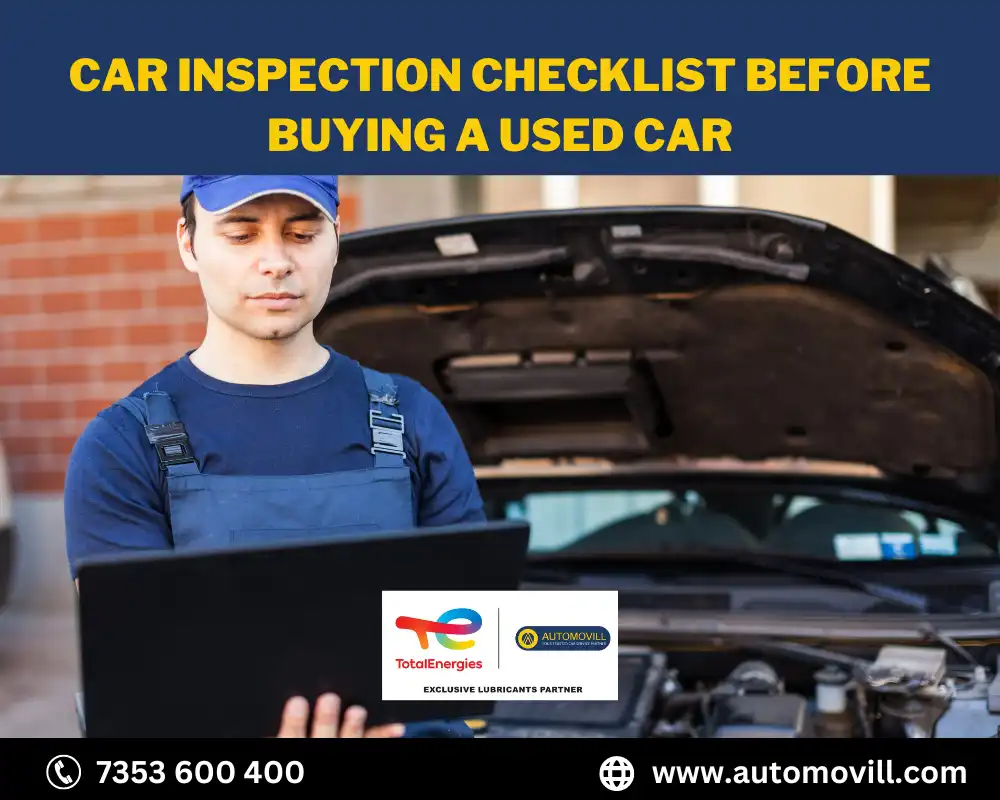
Buying a car is a happy feeling for any individual, in fact for an entire family. But all the happiness can be ruined if you choose the wrong car or which was not well maintained.
So, it’s essential to be cautious and conduct a thorough inspection from a skilled mechanic at a reputed workshop.
In this guide, we’ll walk you through the key steps of inspecting a used car to ensure you make a smart and informed decision.
1. Why is Car Inspection Necessary?
- Understanding the importance of inspecting a used car
- Identifying potential hidden issues that could lead to costly repairs
- Ensuring safety and reliability on the road
2. Exterior Inspection
- Checking for signs of accidents, rust, or paint mismatch
- Examining the tires for wear and alignment issues
- Inspecting lights, mirrors, and windows for functionality
3. Check the Suspension
- Look for signs of sagging, uneven tire wear, or oil leakage around the shock absorbers.
- Bounce each corner of the car to test the shock absorber’s responsiveness; the car should settle back to its original position without excessive bouncing.
- Listen for any unusual noises or squeaks while driving over bumps or rough terrain, as these could indicate suspension issues.
- A well-maintained suspension ensures a smoother and more comfortable ride, as well as better handling and control on the road.
4. Interior Inspection
- Verifying the odometer reading and checking for signs of mileage tampering
- Testing all seat adjustments, seatbelts, and interior features (radio, air conditioning, etc.)
- Checking for unusual smells or signs of water damage
- Also, check for unusual sounds while driving
5. Look Under the Hood
- Examining the engine for oil leaks or excessive dirt
- Check coolant level, Gear fluid, Power steering fluid, etc
- Checking the battery, belts, and hoses for wear and tear
- Check the fuel filter, fuel injector, oil filter, and oxygen sensor
- Check AC cooling, Freon leakage, and compressor condition
- Jerking while accelerating
- Engine overheating on a long drive
6. Test Drive
- Taking the car on a variety of roads (highways, local streets) to assess its performance
- Paying attention to unusual noises, vibrations, or handling issues
- Testing the brakes, acceleration, and steering response
7. Vehicle History Report
- Obtaining a detailed vehicle history report through 3rd party service providers
- Checking for past accidents, title issues, and maintenance/service records
- Verifying if the car has a salvage title or has been involved in flood damage
8. Mechanic Inspection
- Seeking a professional mechanic’s opinion at Automovill on the car’s condition
- Discussing the findings and potential repair costs with the seller
- Using the inspection results to negotiate a fair price
9. Negotiating the Price
- Using the inspection results to your advantage during price negotiations
- Being prepared to walk away if the seller is unwilling to address critical issues
10. Paperwork and Documentation
- Ensuring all necessary paperwork is in order, including the title, registration, and emissions certificates
- Obtaining a bill of sale that includes both parties’ information and agreed-upon terms
- Understanding the warranty and return policy (if applicable)
11. Finalizing the Purchase
- Making the payment through a secure method, avoiding cash transactions
- Getting the necessary signatures and transferring ownership officially
- Obtaining a receipt and a copy of the signed agreement for your records
Conclusion:
Buying a used car can be a rewarding experience when done right. By following this comprehensive car inspection guide, you can minimize the risk of buying a lemon and ensure you’re investing in a reliable vehicle.
Taking the time to inspect the car thoroughly, using professional help if needed, and negotiating wisely will put you on the path to finding the perfect used car that meets your needs and budget.
Happy car hunting!

